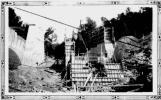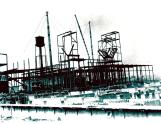1
Dalhousie changed forever in the late 1920s. Word that a giant paper mill would be built there turned it into a boom town.3
Mill construction was one of the largest projects New Brunswick had seen up to that point. Thousands of workers were brought in for the giant project. New businesses, including a newspaper, opened to take advantage of the money that was flowing.4
The way the mill dominated the town is obvious in this picture.1929
Dalhousie, New Brunswick, Canada

5
The dam project was as much of an engineering feat as the building of the mill.1929
Dalhousie, New Brunswick, Canada

7
Although sawmills were still operating, the paper mill was obviously destined to dominate the town.1929
Dalhousie, New Brunswick, Canada

8
The old sawmills were dwarfed and would soon find themselves gobbled up by the paper company. The New Brunswick International Paper Company bought mills in many areas, mainly to obtain their woodland holdings.10
Existing buildings were pressed into service in one form or another, serving as offices during construction or, like this one, as a first aid station.11
Mills need water. To serve the NBIP mill, a hundred foot high dam was built on the Charlo River.1929
Dalhousie, New Brunswick, Canada

12
To provide water for the mill, a large dam was constructed on the Charlo River. It is still the source of water for the mill and for the town.As well, a dam and power plant were built at Grand Falls on the St. John River, over 100 miles away. The transmission line from that plant to the mill was hailed as a major accomplishment.



